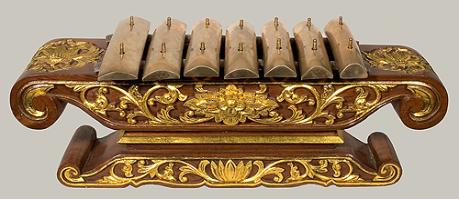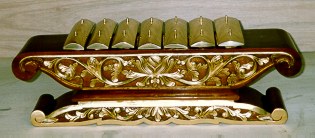      |
SARON BARON Saron Barung has the medium size metal bars. In Saron Barung, the higher the pitch the bar will become smaller and thicker. The mallets for Saron Barung are smaller in size. It has a wooden handle and a wooden barrel-shaped head. The barrel-shaped head is detachable from the handle. This barrel-shaped head is secured to the wooden handle by a hole drilled about halfway through. Because of the thickness of the metal bars, the mallets used to strike on all Saron instruments have to be very hard. During playing, the player needs to struck strongly too. SARON PEKIN The saron pekin / penerus plays the basic or skeletal melody of the music. The basic of the melody is an abstraction of the melody played by the elaborating instruments (gambang / bonang). Usually the notation for any piece of music will be limited to the part played by the saron instruments. BONANG Bonang are actually gong-chimes arranged in two rows. A typical gamelan usually has 14 bonangs, two rows of seven. Sometimes there are only 12. The wooden rack that is supporting the bonangs looks like small bad-frames. In the middle of the frame there are a number of open squares where two parallel cords pass through each square. The bonangs rest in these individual squares and are supported by the cord. The knobs of the gongs are facing up. During playing, the player will struck on the knob with sticks that are lightly padded with coiled string. GAMBANG Gambang is referred as a wooden bar Gambang. The wood used for the Gambang must be very hard. A type of wood known as berlian is normally used to make Gambang's bars. The wooden case to support these bars is like the saron's, but it is much deeper and with thinner sides. The purpose of this case is to act as a resonator. The player needs two mallets to play on a Gambang. The Gambang usually play the fastest part in the gamelan. KENONG Kenong is the largest cradled gong. The Kenong comes in different sizes. The height of a smallest Kenong, from the rim to the top of the knob is approximately 32cm, and the diameter is about 34cm. The largest Kenong has a similar height, but the diameter is approximately 37cm. Usually, there are more Kenongs in a gamelan because all gamelan pieces require Kenongs. The numbers of Kenong varied in different gamelans; however, normally there are about ten Kenongs in a gamelan. All Kenongs are arranged around the Kenong player. Because of this setting, sometimes we called this gong-chime. The player will strike on the knob with sticks that are lightly padded with coiled string. GONG Gong Ageng is the largest hanging gong in Javanese gamelan. It is also the lowest-pitched gong in the gamelan. Gong Ageng has a flat surface with a protruding knob at the center of the sphere. The number of Gong Ageng in a Javanese gamelan varied from gamelan to gamelan. Usually there will be at least one Gong Ageng, and it is usually hang at the back of the gamelan. It is certainly the heaviest and the most expensive item in the gamelan. The mallet used to strike the Gong Ageng has a bigger spherical heads then other mallets, and is covered with heavy padding. The player has to play very gentle on Gong Ageng. GENDANG The gendang usually has the function of keeping the tempo while changing the density or rhythm and signaling some of the transitions to sections and the end of the piece. In dance or wayang, the gendang player must follow the movements of the dancer, and communicate them to the other players in the ensemble of gamelan. |
